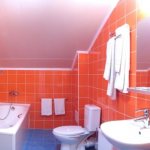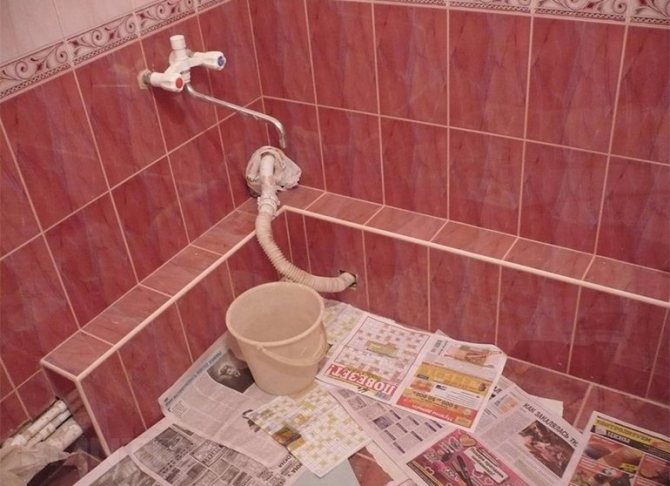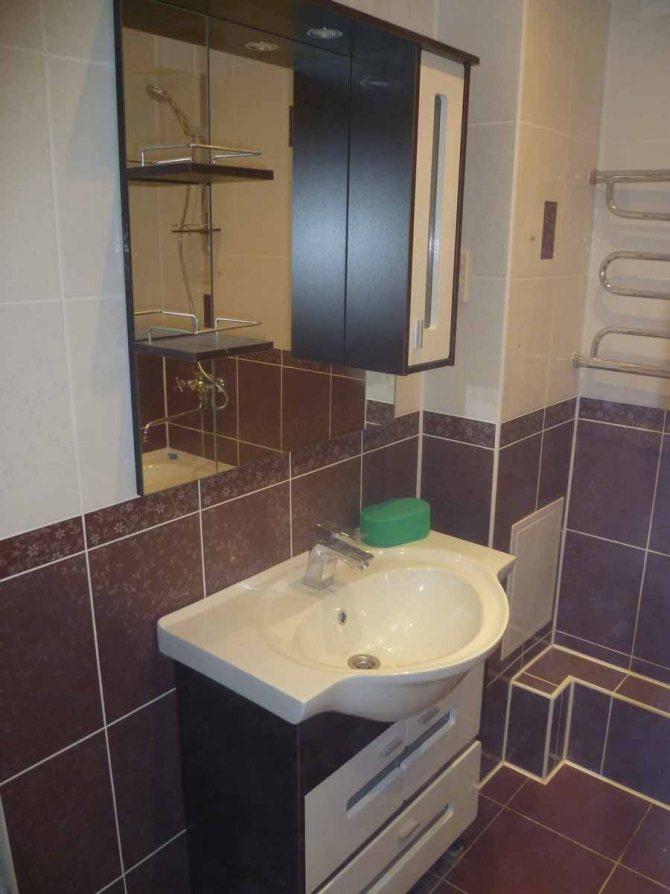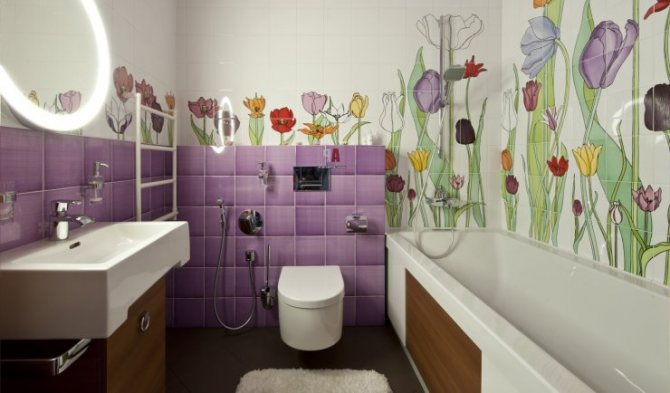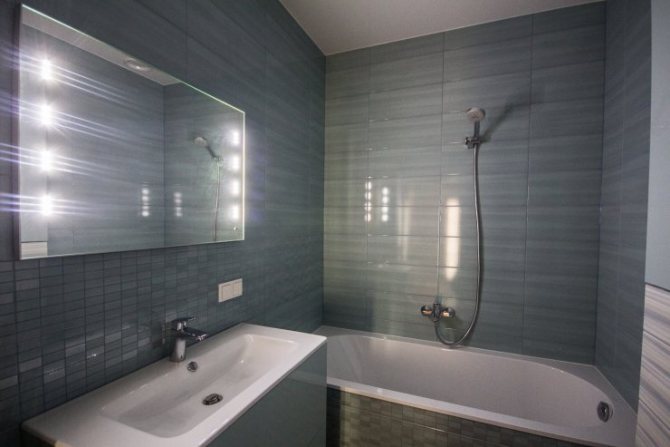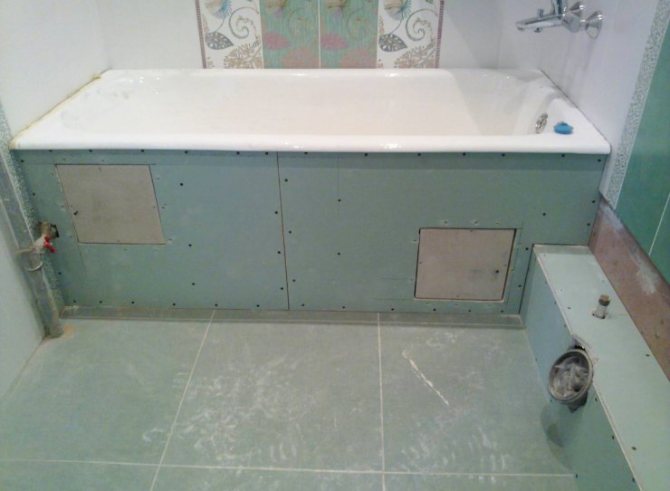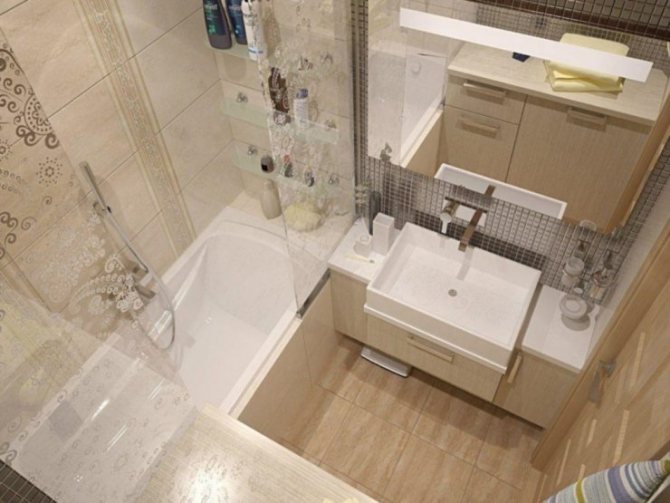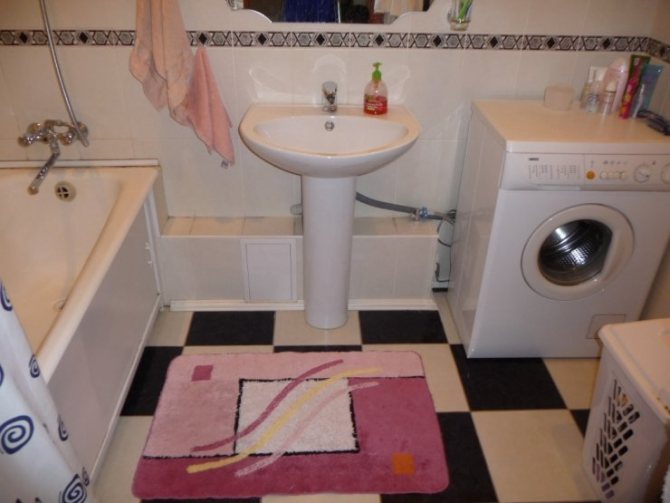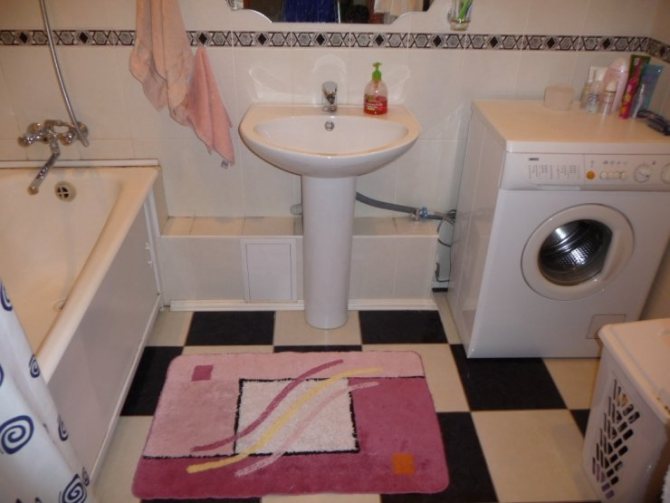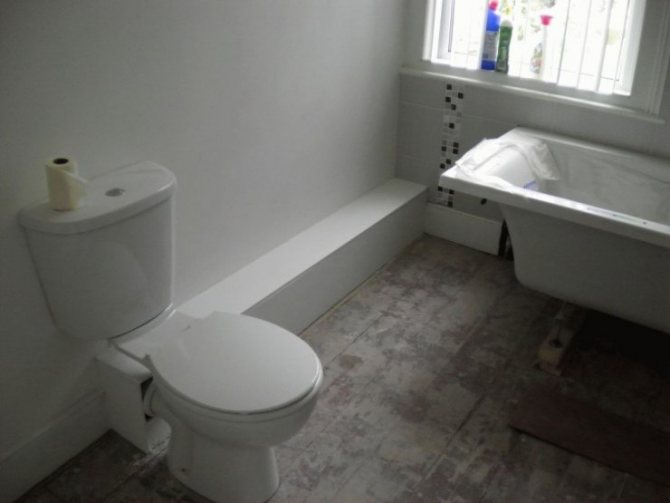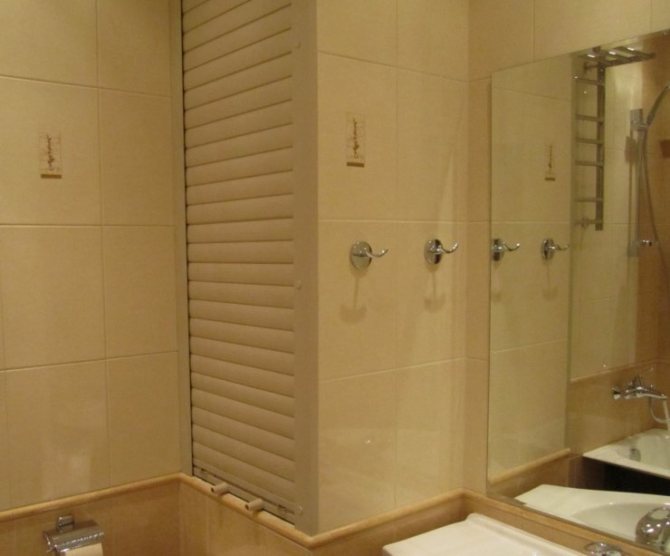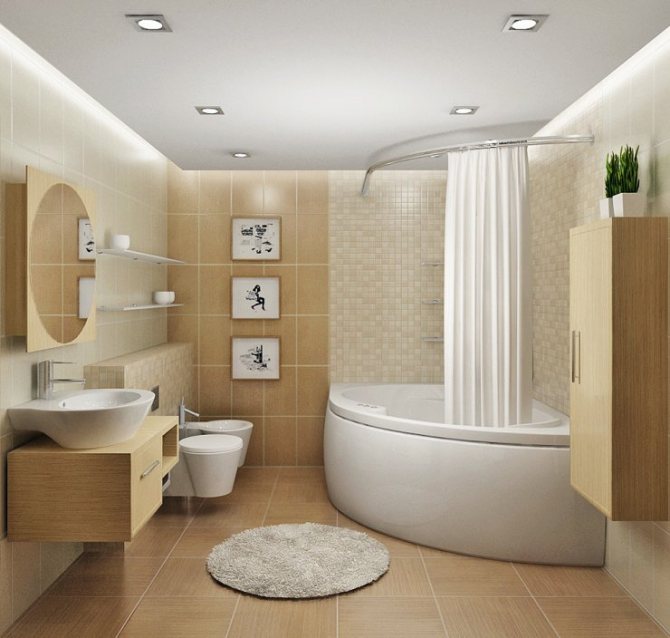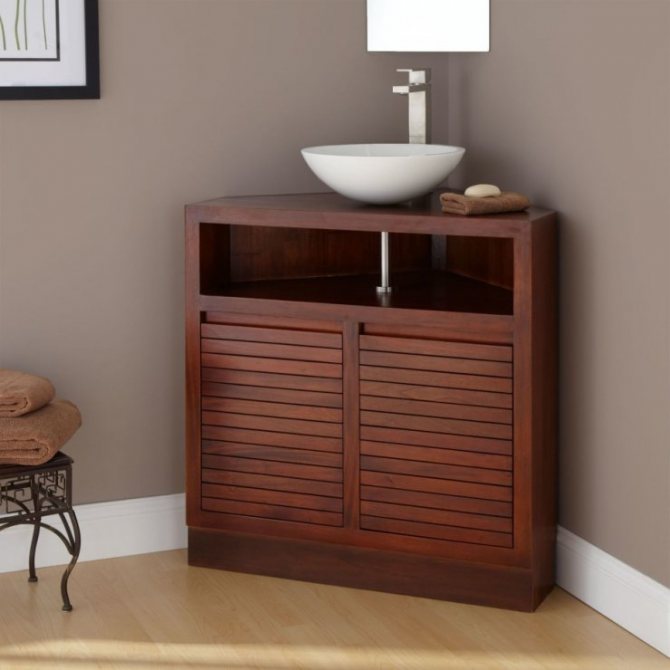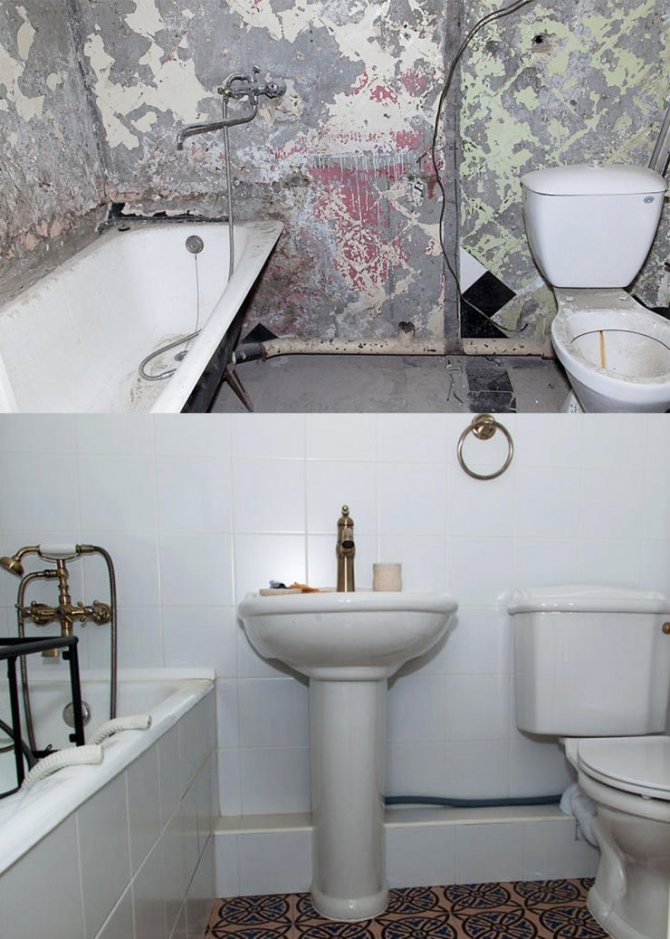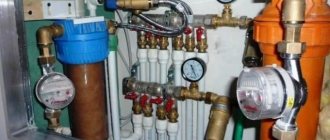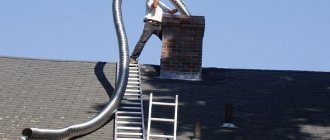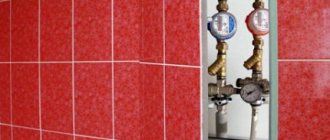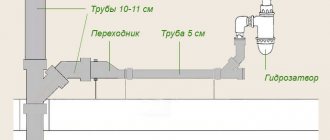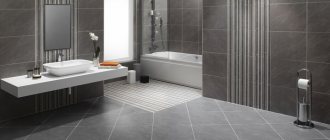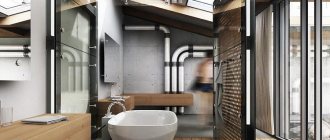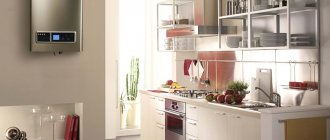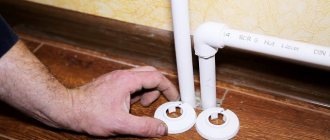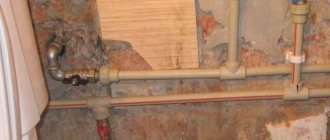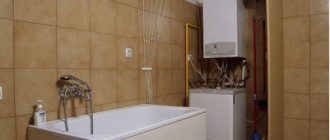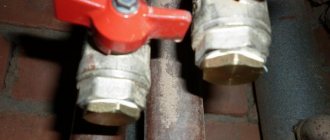Currently, modern renovation in the bathroom, kitchen, and in all other rooms should visually create a holistic picture. Therefore, all plumbing and sewerage pipes must be hidden behind a beautiful finish. This also applies to the risers in the bathroom.
Bathroom pipes hidden in a tiled wooden box are the perfect design solution.
How to close a riser in a bathroom or kitchen, what materials to use for this, how simple is it, what are the nuances, etc.? Here is an incomplete list of questions that arise during the work to close the risers.
It also happens, of course, that the sewer pipes are not located in the bathroom or kitchen itself, but in the sewer shaft.
The combined bathroom and toilet almost always have communications passing through a visible riser. The worst option is the riser in the kitchen. The ways and materials to hide the risers in the bathroom and in the kitchen will be discussed further.
We prepare materials and tools
To mask the pipeline, we need:
- Frame elements. You can use galvanized steel profiles and wooden beams, but the first option is more technological and less prone to deformation under the influence of moisture.
Advice! If you nevertheless decide to make cladding on a wooden frame, be sure to treat all parts with waterproofing impregnation with antibacterial components.
- Hyposcarton. It is best to use moisture resistant sheets. Their price is slightly higher, but they will not swell from condensation and will retain their shape longer.
- Self-tapping screws for drywall and frame. For a tree - ordinary, for a metal profile - with a drill.
- Inspection hatches through which the pipes will be accessed.
- Materials for finishing the plasterboard box - putty, mesh for gluing seams, primer, interior paint or ceramic tiles.
- If the box is being erected to mask heating batteries (which, in general, is not worth doing), then it is imperative to take care of installing plastic or metal gratings through which heat will enter the room.
As for the set of tools, it will be quite standard:
- Rotary hammer or hammer drill.
- Drywall screwdriver for drywall work.
- Metal shears for profile trimming.
- Knife or saw for gypsum board.
As for the finishing tools, they need to be selected in accordance with the chosen decor. List all spatulas, brushes, half-trowels, etc. hardly necessary - if necessary, you can easily figure it out!
How can you hide sewer pipes in the bathroom and toilet: methods and their features
The issue of aesthetics in the arrangement of any pipeline is no less important than the functionality and reliability of the system. This problem is especially acute in areas of an apartment or house where the main water supply lines are concentrated: in the toilet and bathroom. There are many ways to close a sewer pipe in a bathroom or toilet. And each of them has its own advantages and disadvantages.
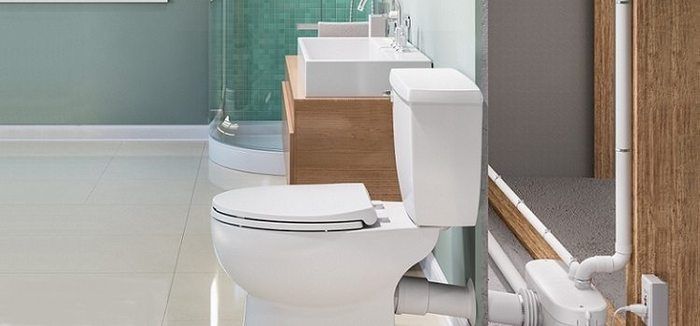
The pipes in the bathroom are closed in order to give the room a neat and aesthetic appearance.
Stage 1. Preparatory work
Before you sew up the riser in the bathroom, experts recommend eliminating all possible faults in the sewage system and water supply. Let's figure out what this means.Sewer pipes should not have cracks, if you notice a crack, then such a pipe is immediately replaced with a new one. If you feel a specific sewer odor, then the joints and hatches should be properly coated with silicone sealant. Also pay attention that the places where the pipes pass through the ceilings of the room are carefully treated with cement mortar.
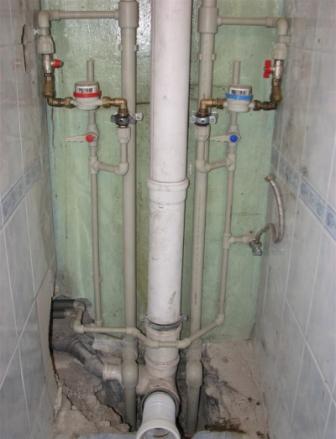

The above referred to sewer pipes, now let's move on to water pipes.
Firstly, they should not have any traces of corrosion. If there are any, then they must be removed, and the pipe must be painted with waterproof paint. As additional protection, a casing made of expanded polypropylene can be put on the pipe. Such a casing will protect the pipe from sudden temperature changes and partially solve the problem of condensation. The second thing to do is to check the functionality of the taps supplying water, to see the state of the threads on the connections. It is recommended to coat the movable joints with some kind of anti-corrosion compound.
How to hide pipes in the toilet and bathroom: basic ways
If the water supply system is being laid for the first time or a major overhaul is being carried out in the house, then it is possible to lay pipes into the wall (chipping). Calculations of the location of pipes are made when creating a water supply plan. It is not recommended to hide sewer pipes with a large diameter in the wall in this way. After all, if the wall is “cut to such a depth, it can negatively affect the integrity of the load-bearing structures of the house. You can hide in the grooves a pipeline with a diameter of up to 50 mm.
It is also possible to hide the plumbing wiring by means of installation in the floor. In this case, the pipes are laid on the floor slabs and filled with cement screed. Naturally, the pipe material must be designed to be located under the screed, that is, to withstand a certain pressure. It is especially worth paying attention to this when choosing plastic pipes for water supply.
But if the installation of the pipeline has already been carried out by an open method, then the only option for hiding the pipes is to create decorative structures in the toilet or bathroom.
All methods of installing structures in order to disguise the sewer pipe in the toilet and bathroom have very similar principles. Their main difference will be the choice of an easy-to-use material that will provide a bathroom or toilet with an aesthetic appearance.
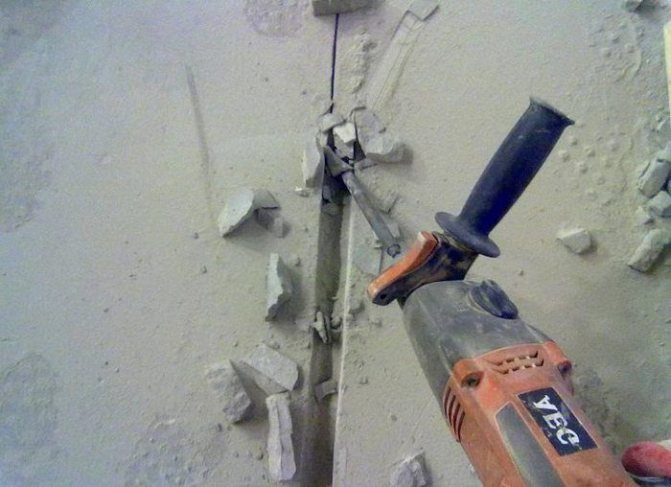

Small-diameter water pipes can be hidden in specially prepared recesses in the wall - grooves
In addition to external characteristics, there are several basic rules for choosing finishing materials:
- The selected materials should be easy to clean: easy to clean, not exposed to aggressive cleaning agents. It also excludes the possibility of using materials that are prone to corrosion.
- Very compact designs are obtained from light and thin materials, which is important for bathrooms with a small area.
- The material should not deteriorate from moisture, temperature extremes and atmospheric pressure. When heated or cooled, they should not release any substances harmful to health.
There are a lot of materials suitable for these requirements. In order to hide pipes in the bathroom and toilet, moisture-resistant types of drywall or plywood, MDF, decorative plastic panels are used.
How to properly hide the sewer pipes in the bathroom and toilet?
The main rule that should be followed when choosing a method for masking a pipeline is to preserve the ability to access communications. The camouflage structure must be such that it can be easily opened and closed in the event of a breakdown in the plumbing system. If sufficient attention has not been paid to this detail, in the event of a force majeure situation, the decorative wall will have to be completely broken.
Good to know! In some apartments, when designing bathrooms, special niches in the wall for laying pipes were originally planned. In this case, the recess with the pipeline is simply laid with plasterboard or plastic. This is the ideal way to hide the pipe - in this case, the area of the bathroom does not decrease.
If there are water meters or valves in the communications, then to access them you need to use the method of installing an inspection hatch. It is possible to mount the inspection hatch, if necessary, even after laying the decorative wall. To do this, it is enough to cut a hole of the required size in it, and then close it with a plastic hatch with a door.
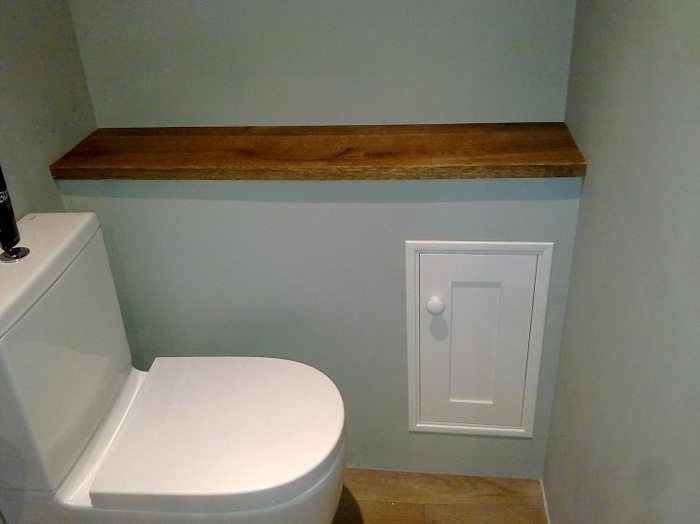

When closing the pipes with a false wall, it is imperative to arrange a door in it for access to communications
Before starting the installation of a structure that hides the pipeline, it is necessary to make sure that there are no defects in the pipe connections. There should be no leaks or deformations in the system. The connecting elements must be well sealed, and the sewer pipes must have the required angle of inclination.
Stage 2. Selection of materials
When deciding how to close up the riser in the bathroom, it is imperative to provide for the possibility of trouble-free access to communications in any of their areas. Otherwise, there will subsequently be a need to ruin all the design work in order to get to the pipe and fix the malfunction.
Brick, monolith and other structures of the same degree of strength are completely unsuitable as materials for embedding the riser. Lightweight materials such as drywall sheets or rough particle boards are much better suited. It is better not to use materials that do not react well to high humidity and sudden temperature changes, therefore plywood, chipboard, furniture boards disappear.
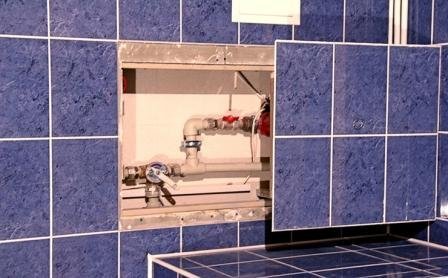

Another important point is that the sheathing frame covering the riser should provide an opportunity to easily get to the joints of the sewer and water pipes. Also, care must be taken that the inspection hatches for water meters and valves fulfill their purpose, and it would always be possible to change the same meters if such a need arises.
How to cover sewer pipes in a toilet or bathroom with decorative panels
Plastic or plasterboard panels (false walls) are one of the best options for how to close up (hide) a sewer pipe in a toilet with a small area. You can also close communications and bathrooms. The false wall can be finished by any method, for example, ceramic tiles are often used. There are also plastic panels of various textures and colors on sale that do not require additional finishing.
PVC plastic panels are used to decorate the walls in the bathroom and toilet. Their dimensions can be as follows:
- thickness: 5 to 10 mm. The more false wall, the stronger the panel should be;
- length: from 260 to 600 cm;
- width: from 10 to 50 cm.
If the false wall is made of drywall, you should purchase a primer and putty for grouting. For maximum protection of the plasterboard wall from moisture, you can treat the inside of the structure with linseed oil. Plastic panels are moisture resistant and equipped with special locks at the edges of the products, so they can be used to close communications without additional funds.
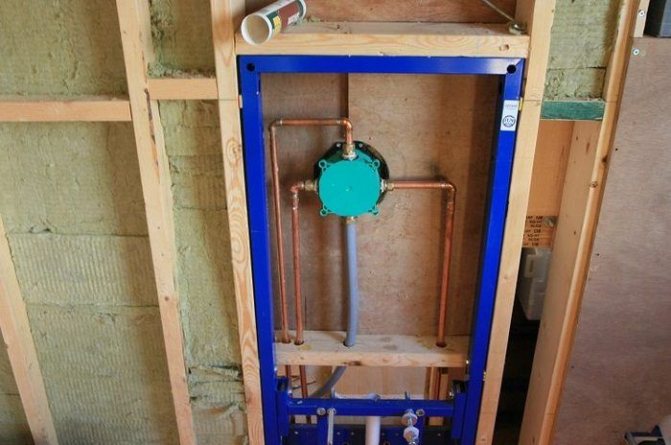

To fix decorative panels, you need to mount the crate
If you do not plan to install an inspection hatch, it is better to finish the bathroom with plastic panels. It is not recommended to use drywall and in cases where it is necessary to hide old pipes.In the event of an accident, the plastic wall can be dismantled easily and quickly, unlike a plasterboard partition lined with tiles.
Installation of false walls is carried out end-to-end to the ceiling and floor. The minimum distance from the main wall to the decorative one is taken, from 70 to 100 mm. To install the panel, load-bearing bases made of aluminum profiles, preferably galvanized ones, are mounted. The distance between the guide profiles is calculated depending on the wall area - from 30 to 60 cm. The metal frame is sheathed with finishing material using self-tapping screws.
Corner profiles, starter strips and skirting boards are used to hide the turns, edges and corners of the structure. It is better to seal the joints of panels with profiles with silicone sealant after installation.
How to hide sewer pipes in a toilet: drywall or plastic boxes
The box is one of the varieties of false walls. Installation will be similar, with the only difference that they can only hide pipes, they will not occupy the entire wall.
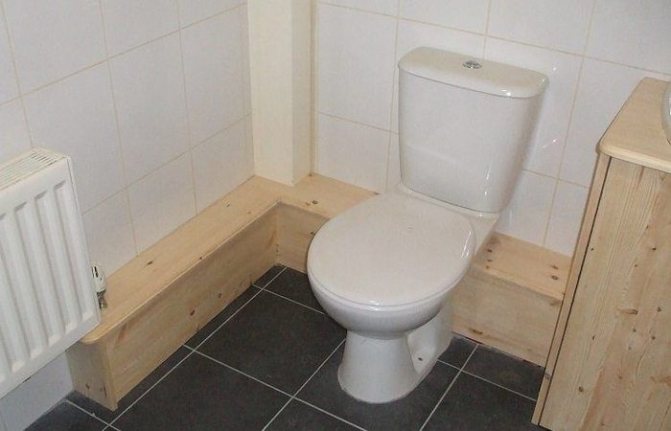

Instead of a whole false wall, you can build a small box made of wood or drywall
A box or podium (if you want to hide horizontal pipes) can be a great place to store tools or household chemicals.
Helpful advice! When installing boxes, the material should be selected so that it does not have to be joined vertically (for example, panels with a complex pattern). In this case, additional support strips may be needed to maintain rigidity.
A functional option in order to hide the pipeline in the bathroom and toilet is a box-closet. Its installation is somewhat more complicated than the installation of simple boxes, but this design is practical. To simplify the work, you can purchase ready-made doors for boxes-cabinets.
The frame for this type of boxes will have to be made of wood. Before work, the bars must be treated with an antiseptic that protects the tree from fungus and rotting. The walls of the box-cabinet can be made of plasterboard, plywood or laminated material. It is better not to put the lower part of the box directly on the floor in the toilet or bathroom, so as not to spoil it in the event of a water spill. Legs with a height of at least 5-7 cm can become the basis for the box.
On the modern market, you can find ready-made boxes to hide pipes. If they are suitable for a bathroom in terms of size and style, then you can hide the pipes with such a factory structure. This significantly reduces the time spent on finishing the premises.
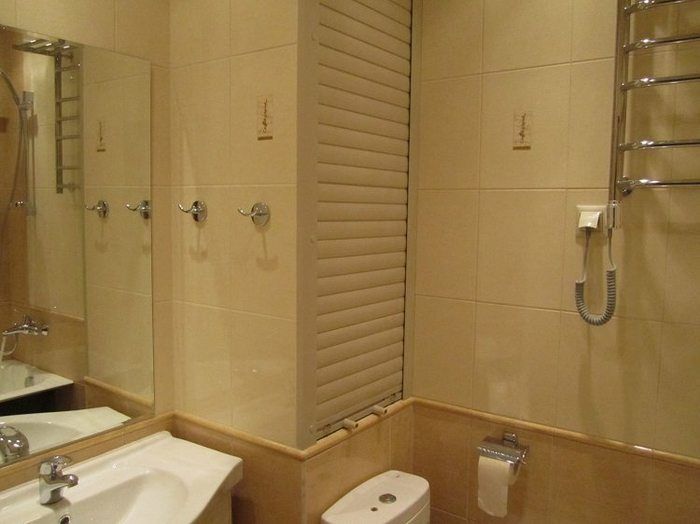

If space permits, you can arrange a pipe cabinet with sliding doors or roller shutters.
How can you hide sewer pipes in the bathroom using roller shutters
Roller shutters (roller shutters, blinds) are a good option for masking pipes. This method is notable for the fact that roller shutters allow constant access to pipes. But the installation of these elements has some peculiarities and difficulties.
Roller shutters are installed on an already existing base, that is, installation of false walls or boxes cannot be avoided. A window must be cut in the decorative panel, as is the case with the installation of an inspection hatch. And only after that the roller shutters are mounted in the hole. It is noteworthy that not all such designs available on the market are suitable for this purpose. It is worth buying only special modifications for plumbing. They differ from conventional roller shutters in that they are made of stainless steel or plastic.
For a bathroom or toilet, you can also choose blinds with electric motors hidden in a moisture-proof box. But in the event that the width of the opening is less than 52 cm, you will have to use blinds that can only be opened and closed manually.
You can close the pipes in the toilet by making a drywall box. This is perhaps the most popular solution.This is because the technology is very plastic; pipes of any configuration can be hidden.
Another nice bonus is the multiple finishes: lay the tiles on glue, level the surface with putty, then paint or glue the wallpaper. A decorative box for covering pipes will work in most cases. Depending on the placement of communications, it can be made in several versions.
Choosing the right option
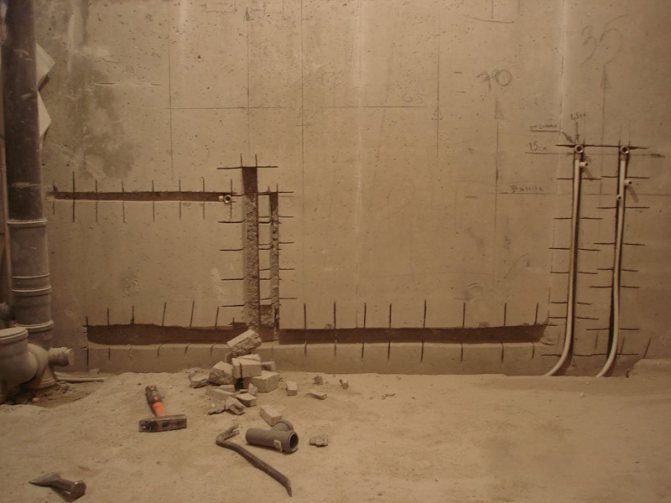

The strobe for the hot water pipe must be made a little larger, since the pipe can expand when heated.
Pipes can be closed in several ways:
- The pipes are hidden in the walls. However, this can be convenient only if the design of the room is done from scratch. This method is dangerous in that in case of a breakthrough or any malfunctions in the system, it may be necessary to disassemble the wall behind which the riser is located;
- Sometimes the bathroom riser is hidden by redevelopment or by combining the bathroom and toilet. The additional space obtained when combining helps to hide the riser with the help of a frame made of a profile and sheathed with plasterboard;
- A separate box or screen is made. This method is convenient in that it does not limit the approach to the pipes in any way and is easily dismantled if necessary;

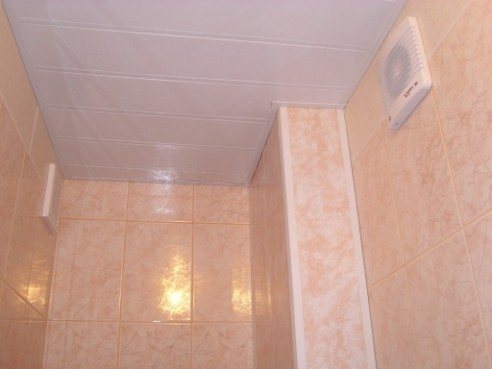
Misting of the pipes is inevitable, so wrap the pipes with insulating material before you hide them. - For the kitchen, a method of installing furniture covering the riser is suitable.
Each method should be chosen individually, depending on the financial capabilities and conditions of a particular room.
The most popular way to hide the riser in the bathroom is the installation of a plasterboard structure, which allows, if necessary, to open access to communications.
How to close the risers in the bathroom - practical and aesthetic solutions for the bathroom
In this article, we will tell the secrets of experienced finishers how to close the riser in the bathroom with drywall or other material so that it looks beautiful, but does not interfere with the maintenance of communications. Please note that the plastic box cannot be tiled or any other finishing material, it is impossible even paint. Therefore, immediately choose the panels of the color and design that suit you.
Note! Many homeowners, when mounting a box under pipes made of moisture-resistant plasterboard, followed by tiling, do not make an inspection window for fear of spoiling the appearance of the structure. However, now in hardware stores, invisible revisions are presented, which are tiled and do not stand out against the general background of false walls. Very often, master finishers recommend building a false wall to hide pipes, risers and other communications from plastic panels.
They are lightweight, inexpensive, moisture resistant, easy to clean and easy to assemble.
- First, we mount a masking box around the riser made of metal guides, plastic profiles or wooden blocks.
- Then, on the top and bottom of the box, we let the fixing strip for the panels.
- After that, carefully close the box with plastic panels.
- At the final stage, we glue the corners to the outer corners with silicone glue so that the structure looks neat.
Methods for masking a riser
So how can you close the riser in the bathroom? This can be done in a variety of ways:
- Disguise in the walls. In this way, you can hide the riser only at the stage of its installation. And the work is very difficult and time consuming, be prepared for this. First, you need to draw up and transfer to the wall a diagram of the location of all communications. Then, using a perforator, recesses should be made slightly larger than the diameter of the pipes. Further, pipes are placed in the grooves.Then it is advisable to cover the entire surface with plasterboard, chipboard, plywood or PVC panels to make a kind of false wall. It is not recommended to fill the recesses with concrete; in case of breakdowns and dismantling, you can severely damage the riser.
- Cupboard. Yes, you can hide the riser in the closet. Moreover, you can either purchase a ready-made piece of furniture with a missing back wall and slots in the shelves, or make it yourself from a regular one. You will need to dismantle the back. Then, using a crown and a drill, make holes in the shelves of the corresponding diameter for the pipes. This method will allow not only to hide the riser, but also to provide additional space for storing products or hygiene items.
- The box is the most common way to mask communications. It is convenient in that you can purchase a ready-made structure of the required dimensions at a plumbing store. It is easy to install, so it's easy to install. In addition, there are different options for shapes and configurations: triangular, rounded, rectangular boxes, as well as consisting of one or more levels.
- Plasterboard partition. To mount it, you first need to install a solid frame, which is usually made of galvanized profiles. Although some use wooden beams, this material requires additional treatment with moisture-proof and antifungal agents. Further, drywall sheets themselves are attached to the frame using self-tapping screws, and it is advisable to use moisture-resistant ones, since the humidity in the bathroom is significantly increased. The next stage is finishing. Different materials can be used, but PVC panels and ceramic tiles are the most practical and preferable.
- Plastic panel construction. Plastic panels are practical, inexpensive, moisture resistant, lightweight and relatively easy to install, as they have convenient joints. But the only drawback of using them is the complete absence of noise isolation, any sounds will penetrate through them. If this does not bother you, then get down to work. First, install a frame that can be manufactured in the same way as for a plasterboard partition. But in this case, it is desirable to use a metal profile. Install plastic panels on it. The joints can be masked with corners.
- Roller shutters will not only hide all communications from the eyes, but also leave unhindered access to them. You can move the shutter at any time to, for example, open or close a valve or troubleshoot problems. Roller shutters are installed in guides. In this case, the riser itself should be located in a recess so that it does not interfere with the movement of the shutter. And along the edges of such a recess, the frame of the future structure is just mounted. Currently, you can purchase special roller shutters designed for bathrooms and toilets. They not only play the role of camouflage, but also perform hydro and noise insulation functions, as they are equipped with an additional inner coating.
How to hide pipes in the toilet - popular ways
When renovating toilets, the question always arises of how to hide the pipes in the toilet. After all, the look of the pipeline gives the impression of “eternal repair. The building materials market offers many types of finishing materials that can mask a technical unit. Such a box can be tiled and made invisible. The cost of creating a GKL box will be slightly higher than sheathing with plastic panels. One of the simplest designs. Plasterboard or plastic is useful for plating pipes.
This method is quite simple: it is enough to purchase a sheet of drywall, preferably moisture resistant. The cost of one sheet is about $ 4.5. In addition to the gypsum board, you will need a profile.
It can be made of wood or metal. It is better to choose a metal profile.It is of two types:
- Guide. They form a contour and are attached at 4 corners, at a distance of at least 10 cm from the pipes.
- Wall. Serve to strengthen the structure.
If the height of the box is less than a meter, then you can do without them. After installing the frame, the drywall sheet is attached to it with self-tapping screws.
Plasterboard box to hide the riser
- sewer risers with 100 cross-sectional diameters;
- water pipes with meters;
- built-in toilet installation;
- comb (distribution unit) of warm floors;
- gas meter;
- technical points with supply valves, compensators, pressure reducers, compensators.
The edges of the gypsum board at the joints of the outer corners are trimmed with a gypsum plane. So they dock without gaps. After that, finishing begins. On the basis of the diagram and the markings, the calculation of the material is made.
Please note that in the case when the width of the box in the toilet under the riser is no more than 25 cm, it is possible not to install transverse jumpers.For a wall-to-wall, non-corner construction, both outer corners must be exactly 90⁰. Recheck the labels, as correct assembly depends on them. In the bathroom, moisture-resistant sheets are used.
Cut out drywall according to the size of the boxes. To do this, they outline the dimensions, cut them according to the marks with a construction knife and break it (you can find out how to properly cut a drywall sheet on our website). Sew up the box using drywall screws 3.5 x 9.5 mm.
Better to buy brass, oxidized fasteners, it does not corrode. This is the simplest and most affordable method of masking communications. With the help of drywall, structures of any type are created: one-, two-level. The advantage of this method is that it is easy to install. The disadvantages include the sometimes inorganic design of such structures.
In addition, they hide the space in the room. In this case, there is no need to place the plumbing device on top of the constructed structure. This will increase the height of the tub.
In addition, it is very heavy, and the materials available for installation will not withstand such a significant load. To hide the sewer pipes in the bathroom (or plumbing), they create a kind of podium around the plumbing fixture. An important point: in order to prevent deformation of the frame installation during seismic shifts, a special shock-absorbing tape is used.
It is applied to the areas of contact of the working surfaces with the racks. The use of such a tape will allow to neutralize vibrations, preventing them from entering the profile. Thanks to this, protection against destruction of the frame structure is created. The next step is to sew up the constructed base with gypsum-fiber blanks.
Close attention is paid to the following nuances: The choice of method depends on several factors: the size and direction of the pipelines, their location relative to each other, the presence of additional devices, etc. In a private house, everything is easier if you take care of masking communications even before the project is brought to life. Some pipes can be hidden in the walls, and technical hatches can be created for important nodes. Filters and metering devices are installed in a specially designated room - along with a pump and other equipment responsible for water supply at home.
Recommendations to help you avoid mistakes
To hide plumbing and sewer pipes in the bathroom, you should first familiarize yourself with the key points of the process. Before performing installation work, you should consider the design of the future decor so that there is convenient access to the pipes. The water meter and threaded connection must be freely available. Knowing the rules can help you avoid mistakes and reduce installation time.
Experts advise using the following:
- Make sure all communications are working properly. Most people forget that a slope must be provided for the sewer pipes.
- If you are hiding water and sewer pipes, then make sure that there is convenient access to the taps, and for this, make an inspection hatch in the box.
- Threaded joints are the most susceptible to leaks in pipes, therefore it is important to assess in advance the condition of the seals and check the joints for leaks. After that, make plumbing hatches, which will make it possible to carry out repairs if a leak occurs.
- Before closing the communications, decide on how the household appliances will be located, because if you neglect this, then in the future there may be problems with how to bring new equipment.
Most mistakes can be avoided if high-quality materials are used for the work, and it is also important that everything is done accurately during the repair. Neglect of such rules can lead to the fact that leaks will be found in the future, due to which you will have to disassemble the entire structure and make expensive repairs.
How to hide pipes in a toilet
Having analyzed these features, it will be easy to determine the type of future design. The most common are several popular types. A more reliable and thorough way to hide pipes compared to blinds. They have a similar mechanism: when the structure is opened, the strips are collected in a roll or stack inside the box.
They take up more space, but if there is enough space, it is better to give preference to this method of camouflage. Particularly interesting are the automatic models controlled by the remote control. If you need to hide communications quickly, PVC panels will be the best choice.
It is a cheap and versatile finish. The main thing is to choose a color and pattern that will harmoniously fit into the overall picture of the interior. Before hiding the pipes in the toilet, you need to carefully inspect the riser and other communications for damage, and eliminate them if necessary.
It is necessary to start preparing drawings and calculating the material for the future structure after solving all technical issues. For an accurate calculation of raw materials, it is necessary to carefully make all measurements of the area on which the work will be carried out. Pipes can be left in plain sight and not decorated if they look beautiful on their own. For example, metal communications in combination with plumbing from the same material are perfectly combined and fit into the interior of a loft, techno or hi-tech restroom.
In a toilet with such a setting, they will become a source of pride. But such pipes are expensive, in addition, there is a possibility of getting burned.
Important rules ↑
- The sewer riser and other communications laid in an open way should not be closed tightly. It is better not to use capital partitions, choose lightweight materials that can be quickly dismantled in the event of an accident or malfunction.
- Do not build solid structures, but provide windows or doors in them. This method will allow you to periodically check, which will eliminate the need to disassemble the decorative partition for every occasion.
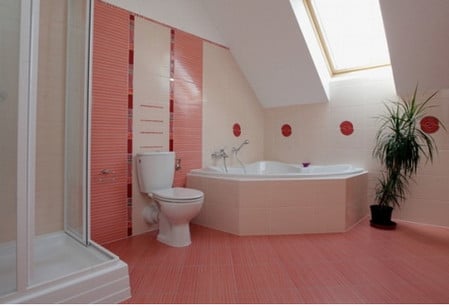

Harmony in the bathroom should not be disturbed by unsightly communications
In order not only to hide the sewer riser, but to reduce the noise level, it is recommended to lay soundproofing, such as mineral wool, between the screen and the pipe.
- When choosing a material for a construction, keep in mind the humidity of the room. Elements that are afraid of moisture must be treated with appropriate solutions and impregnations. If this important point is missed, the decorative screen will turn into an abode of mold, and will quickly lose its attractiveness.
- Before hiding the layout from prying eyes, make sure that the parts are from the same material.This will prevent accidents, reduce depreciation, and extend the service life.
- Cover everything with insulating material to prevent permanent moisture.
How to properly hide pipes in the bathroom under the tiles
Between themselves, the frame parts are fastened with pull-type rivets or also with self-tapping screws. If the frame is made of steel without a protective coating, then after installation in place it is covered with two layers of anti-corrosion paint (it is possible with lead or iron red lead, diluted in drying oil). The surface of the plastic shell is primed with a primer that increases adhesion and finished with mosaics, laying it on a white cement adhesive mixture or a polyurethane-based compound. The routing of water pipes to hide the plumbing system is carried out along the walls before the leveling plastering is performed. So that the plaster layer for covering the pipes does not have to be made unnecessarily thick, channels for the water supply are grooved in the walls of the bathroom.
Using a grinder with a dry cutter, parallel cuts are made at the distance of the diameter of the pipes used, according to the markings previously made on the walls, after which the material between the cuts is cut with a puncher or chisel with a hammer. This situation simplifies the solution of the issue, since installation “from scratch, with a properly thought out sequence of repair work, allows you to repair the bathroom with less effort and time. A thin-walled plastic pipe with an inner diameter equal to the outer diameter of "K-Flex" is selected, and a cut is made along its entire length with a grinder.
The gaps between the pieces of “K-Flex” -shell around the riser are filled with polyurethane foam and, without waiting for its expansion, put on the riser a thin-walled plastic pipe cut along the riser, expanding the slot.

